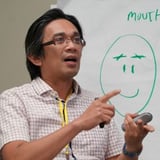Summary
Culture is the glue that holds everything together. When our work lives are disrupted and norms shift, your culture can be at risk. Let’s discuss the role that Design Ops plays in designing and upholding company culture. We'll look at ways to turn your beliefs into behaviors that reinforce healthy creative culture, even in uncertain times.
Key Insights
-
•
Process is rigid and focused on repeatable steps, whereas practice is flexible and adapts to the team's needs.
-
•
Great practices act as guardrails that empower creativity and problem-solving without dictating every detail.
-
•
Transitioning from HQ-centered to fully distributed models requires redesigning processes and practices to support remote work challenges.
-
•
Time and energy are precious resources that must be protected through strategies like team curfews and core collaboration hours.
-
•
Asynchronous communication increases transparency and inclusivity but must be balanced with occasional synchronous meetings to prevent misunderstandings.
-
•
Weekly well-being check-ins using simple tools like emoji responses help teams gauge emotional states and workload capacity remotely.
-
•
Collective fatigue requires intentional well-being practices such as mental health days and scheduled breaks after sprints.
-
•
Psychological safety and trust are cultivated through genuine relationships, leadership openness, and buddy systems.
-
•
Measuring impact rather than activity helps avoid presenteeism and fosters autonomy and engagement.
-
•
Design ops can lead the cultural shift toward more humane, equitable, and resilient ways of working in the design community.
Notable Quotes
"Process is a scary word because smart people do not like to be told what to do."
"IKEA's instruction manual is rigid; you must do exactly what you're told to get a specific result."
"Practices are the guardrails that empower individuals to be creative problem solvers and innovators."
"Great practices help you do more with less and work smarter, not harder."
"We must protect time, energy, mindset, and well-being if we want teams to be resilient."
"Setting team curfews helps people truly log off and come back rested and fresh."
"Asynchronous communication is great until a misunderstanding happens—then a five-minute meeting can fix it."
"Psychological safety comes from good relationships, genuine care, and leadership candor."
"Emoji check-ins are expressive without being specific, creating a safety net for honest communication."
"If we prioritize practices that reduce pain and increase purpose, our teams will thrive despite adversity."
Or choose a question:
















More Videos

"I believed we could do more — more for the company, customers, stakeholders, and ourselves if we had more agency."
Nalini KotamrajuResearch After UX
March 25, 2024

"Availability bias means hiring managers often pick fruit from a tree they haven't planted."
Dean BroadleyNot Black Enough to be White
January 8, 2024

"Silence is complicity. Inaction is support."
Denise Jacobs Nancy Douyon Renee Reid Lisa WelchmanInteractive Keynote: Social Change by Design
January 8, 2024

"People problems find their way to design ops because we’re known problem solvers and people run to us when morale is low."
Kim Fellman CohenMeasuring the Designer Experience
October 23, 2019

"The most common way people give up their power is by thinking they don’t have any."
George AyeThat Quiet Little Voice: When Design and Ethics Collide
November 16, 2022

"Getting exact endorsement from the top helps your cause immensely."
Nathan CurtisBeyond the Toolkit: Spreading a System Across People & Products
June 9, 2016

"Our researchers talk regularly to the CEO and are closely involved in product decisions, making research highly impactful here."
Greg PetroffThe Compass Mission
March 10, 2021

"Traditional design thinking and human-centered design rarely take localized nuances and global trends into account."
Chloe Amos-EdkinsA Cultural Approach: Research in the Context of Glocalisation
March 27, 2023

"We started analytics at the beginning so we could benchmark and compare old and new site performance."
Mackenzie Cockram Sara Branco Cunha Ian FranklinIntegrating Qualitative and Quantitative Research from Discovery to Live
December 16, 2022
















